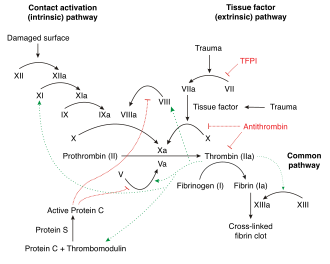Coagulation disorders
From WikiLectures
Physiology of hemocoagulation[edit | edit source]
Hemostasis = a condition in which blood flow is ensured on the one hand, while on the other hand in case of bleeding it stops (x hemocoagulation = function of plasma coagulation factors)
- 1) clot formation - clot
- 2) activation - pledge (limited to the required section)
- 3) breakdown of the clot (so as not to interfere with circulation)
- parts:
- primary hemostasis
- plasma coagulation system
- clotting inhibitors
- fibrinolytic system
- fibrinolysis inhibitors
Hemostasis disorders - coagulopathy[edit | edit source]
It is a bleeding condition caused by a decreased concentration or activity of plasma coagulation factors.
Congenital coagulopathy[edit | edit source]
Hemophilias[edit | edit source]
- congenital defect f.VIII (hemophilia A)
- congenital defect f.IX (hemophilia B)
- recessively inherited X-linked disease, transmissible women
- prenatal diagnostics already 10. − 12. week - a collection of chorionic villi, DNA examination in high-risk families, later blood collection from the fetal umbilical cord
- clinical picture:
- f.VIII ≤ 1%, f.IX ≤ 2% (spontaneous bleeding into joints, muscles)
- f.VIII 5−10%, f.IX 2−6% (bleeding after injuries or operations)
- f.VIII ≥ 10%, f.IX ≥ 6% (light form)
- consequences: typical hemophilic arthropathy to joint amylosis, disability, extensive muscle hematomas, psoatic syndrome
- lab. findings and treatment: aPTT, determination of f.VIII and f.IX; substitution and supportive treatment, prevention of consequences; the therapeutic regime in the hospital - preparation for surgery (treatment of bleeding into the GIT, CNS)
- hemophilia C: defect f.X
- parahemophilia: defect f.V
Von Willebrand's disease[edit | edit source]
- autosomal inherited
- vWF deficiency or malfunction (for platelet adhesion)
- vWF is the carrier for f.VIII
- vWF deficiency can lead to f.VIII deficiency
- bleeding into the skin, mucous membranes, epistaxis, hypermenorrhea
- prolonged bleeding after childbirth, injury, surgical intervention
- at the same time with f.VIII deficiency - bleeding as in hemophilia
- treatment: substitution, in mild cases vasopressin
Acquired coagulopathies[edit | edit source]
Disorder of resorption and utilization of vit. K[edit | edit source]
- insufficient synthesis of factors
- liver cell involvement
- vit.K transport disorder in obstructive jaundice
- intestinal resorption disorder
- overdose of dicoumarin treatment (kamavitiv, frozen plasma, prothrombin complex factor concentrate)
Disseminated intravascular coagulation (DIC)[edit | edit source]
- a necessary evoking moment
- DIC development
- a) the coagulation system is activated (if it is not meant to be) → microthrombus formation → storage in organs
- b) consumption of coagulation material → formation of hypocoagulation state
- c) defibrination
- d) fatal bleeding
- cause: endotoxin leaching, tissue thromboplastin release, proteolytic enzyme leaching, antigen-antibody reaction
- accompanies: obstetric complications, injuries, infections, sepsis, anaphylactic shock
- course: activation phase (microthrombolization), compensated and decompensated phase, excessive activation phase of secondary fibrinolysis
- treatment: substitution of all components (MP, thrombo, fibrinogen, EM), eliminate the inducing moment
Links[edit | edit source]
Related articles[edit | edit source]
Literature[edit | edit source]
PECKA, Miroslav. Laboratorní hematologie v přehledu. [Díl 2.], Fyziologie a patofyziologie krevní buňky. 1. vydání. Český Těšín : Finidr, 2006. ISBN 80-86682-00-5.

